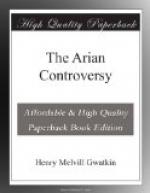It will be seen that the genuine Nicene Creed here given differs in almost every clause from the so-called Nicene Creed of our Communion Service. Leaving, however, the spurious Nicene Creed till we come to it, let us see how the genuine Nicene Creed dealt with Arianism. Its central phrases are the two which refer to essence. Now the essence of a thing is that by which it is what we suppose it to be. We look at it from various points of view, and ascribe to it first one quality and then another. Its essence from any one of these successive points of view is that by which it possesses the corresponding quality. About this unknown something we make no assertion, so that we are committed to no theory whatever. Thus the essence of the Father as God (for this was the point of view) is that unknown and incommunicable something by which He is God. If therefore we explain St. John’s ’an only-begotten who is God’[7] inserting ‘that is, from the essence of the Father,’ we declare that the Divine Sonship is no accident of will, but belongs to the divine nature. It is not an outside matter of creation or adoption, but (so to speak) an organic relation inside that nature. The Father is no more God without the Son than the Son is God without the Father. Again, if we confess him to be of one essence with the Father, we declare him the common possessor with the Father of the one essence which no creature can share, and thus ascribe to him the highest deity in words which allow no evasion or reserve. The two phrases, however, are complementary. From the essence makes a clear distinction: of one essence lays stress on the unity. The word had a Sabellian history, and was used by Marcellus in a Sabellian sense, so that it was justly discredited as Sabellian. Had it stood alone, the creed would have been Sabellian; but at Nicaea it was checked by from the essence. When the later Nicenes, under Semiarian influence, came to give the word another meaning, the check was wisely removed.
[Footnote 7: John i. 18 (the best reading, and certainly familiar in the Nicene age).]
[Sidenote: Its caution.]
Upon the whole, the creed is a cautious document. Though Arianism is attacked again in the clause was made man, which states that the Lord took something more than a human body, there is no attempt to forestall later controversies by a further definition of the meaning of the incarnation. The abrupt pause after the mention of the Holy Spirit is equally significant, for the nature of his divinity was still an open question. Even the heretics are not cursed, for anathema in the Nicene age was no more than the penalty which to a layman was equivalent to the deposition of a cleric. It meant more when it was launched against the dead two hundred years later.
[Sidenote: Arian objections.]
Our accounts of the debate are very fragmentary. Eusebius passes over an unpleasant subject, and Athanasius up and down his writings only tells us what he wants for his immediate purpose. Thus we cannot trace many of the Arian objections to the creed. Knowing, however, as we do that they were carefully discussed, we may presume that they were the standing difficulties of the next generation. These were four in number:—




